The dignitaries of recently built space organisations in Australia and the Netherlands have communicated their desire to do a collaboration with the Indian Space Research Organisation, (ISRO) in their upcoming ventures.
They want to get together with ISRO and work in collaboration with them, progressing in astronomical advancement for all the countries involved.
Australia and the Netherlands, despite decades of knowledge and expertise in space technology, could establish their space agencies only over the last decade.
During the inauguration session on “Building NewSpace in India” at the International Space Conference, the spokesperson of the foreign space agencies expressed their wish and ideas openly.
Australia’s Comments

The Deputy Head of the Australian Space Agency (ASA), Anthony Murfett, conveyed that space will be their prime focus in the forthcoming years.
They plan on operating in various areas, including business, start-up ventures, solutions regarding agricultural transformation and disaster management.
Meanwhile, the three-year-old space agency is seeking to work with domestic as well as international partners.
The Deputy mentions that Australia has partnered with NASA during its Apollo mission, Japan during Hayabusa 1 and 2 and India in its current mission.
This is coming together, indicating that the Indians can trust the Australian agency because of its previous records.
He added that the Australian government is more than pleased and feels immensely proud to be supporting ISRO in its Gaganyaan mission by tracking through Australia’s external dominion on the Keeling or Cocos Islands in the Indian Ocean.
Furthermore, Australia is looking to be a partner or promoter by investing in businesses to develop the economy.
They are also establishing facilities to test space hardware, a command and control facility in Perth, and hopes to use their powerful technology for massive automation and robotics to enhance space technology.
The possibility of immense collaboration opportunities has made Australia and India update their Memorandum of Understanding to highlight their solid reciprocal relationship.
What Netherland said

The Dutch space agency, the Netherlands Space Office (NSO), also revealed their eagerness to partner with ISRO.
The Deputy Director of the agency, Nico Van Putten, said that Air quality monitoring is a lucrative area where Netherlands and India can co-operate.
The TROPOspheric Monitoring Instrument (TROPOMI) has collected massive data on 2017 launched Sentinel 5P mission.
The representative added that more than half of the Netherlands is under sea level; therefore, they focus on agriculture and water.
In discussing NSO, he said that although the official establishment got inaugurated in 2009, it functioned as a founding member of ESA (European Space Agency) for four decades.
The country’s present focus in space technology, including the development of goods and services, concentration of technology, constituents and sub-systems, satellite instruments for observing Earth and using satellite, brought data to analyse agriculture, air quality, climate, water management, and many others other factors.
Putten also shared pictures of nitrogen dioxide monitoring over India, which helps study the difference in air pollution between pre and post-pandemic eras.
About the Conference
The Confederation of Indian Industry, ISRO and other affiliates host the three-day virtual conference to deliberate on specific themes such as opportunities for industries, trends in Satcom, business models, factors for start-up growth, to name a few.
The conference will have eight sessions with more than 65 speakers from ISRO, industry and global space agencies.
Latest update on ISRO’s ventures

According to some sources, ISRO plans to launch two satellites to enable communications and provide tracking support to its human-carrying spacecraft.
The satellites, the Indian Data Relay System Satellites, will be approximately 3600 km above the equator. Apart from this, there will also be ground-based tracking of Gaganyaan as it orbits the Earth.













